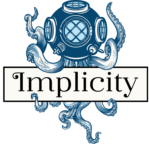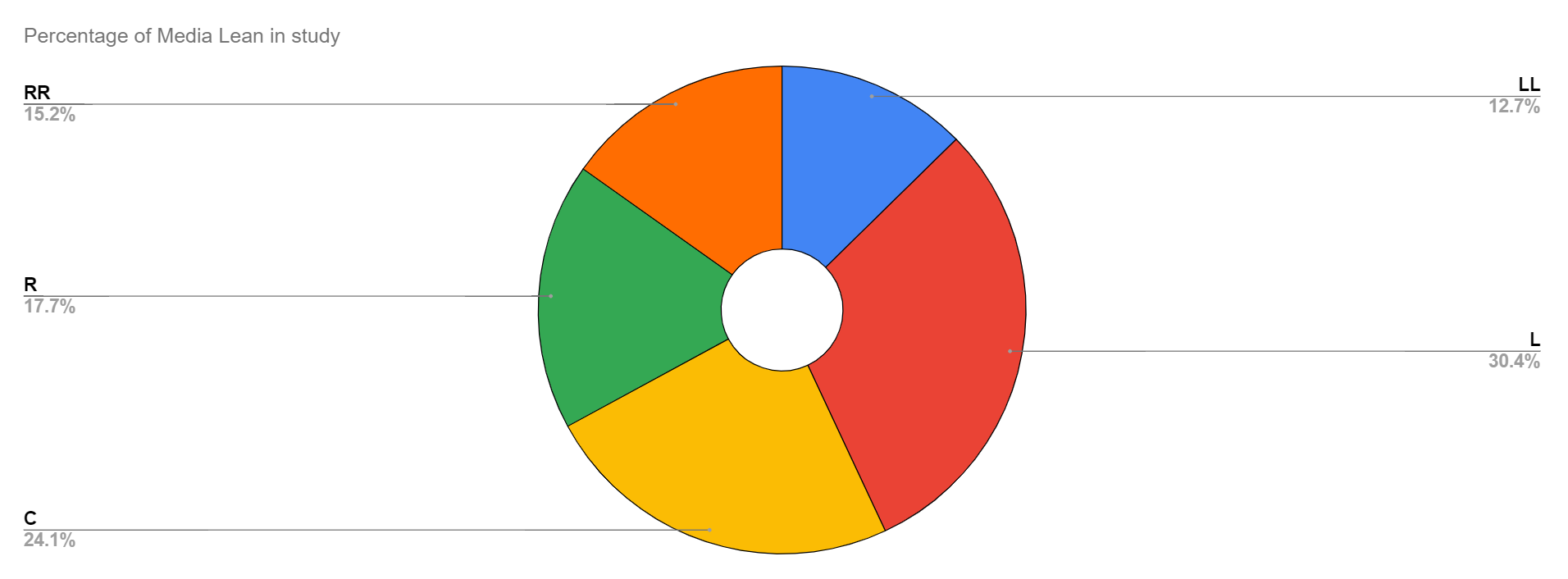Sourcing
We wanted to look at how Q and QAnon were addressed across the digital news media from its inception in 2017 through March 2021. Our definition of news site was that it
- covered current events
- was not one person’s blog (had multiple contributors)
- (possibly) had a corrections/clarifications policy.
Partisan lean of 80 different news websites was determined primarily using
- All Sides
- “Fake News,” Lies and Propaganda: How to Sort Fact from Fiction. University of Michigan, March 8, 2021
- Adfontes Media Bias Chart
- Pew Research Center
When an outlet was not listed in these sources, its editorial and news content was reviewed to determine any partisan lean. This happened primarily with the small, local outlets such as the Arizona Mirror and Helena Independent Record. Outlets were assigned a rank 1-5, with 1= most liberal and 5= most conservative.
Inlinks and traffic ranking were the two other factors in comparing media sites. Data was determined using the Alexa Traffic Rank extension in Chrome.
Breakdown of websites used in this study by lean:
1: 12
2: 22
3: 17
4: 12
5: 11
One of the complicating factors in this study was the dearth of news sites on the far right (5). There are a plethora of blogs but fewer news sites. This is not true for the far left (1), where sites like Huffington Post, Daily Beast, and the New Yorker publish frequently and profusely.
Also skewing the results (but reflecting the media landscape) was the amount that outlets published on a daily or weekly basis. New York Times articles are a lot longer than Newsmax articles. Left and left leaning outlets gave us more words.
The top media sites in the US (by unique visits, according to Statista)
[table “13” not found /]
A complete list of articles is in the data section.
Parsing
A php script was created (thank you Dr. Frechette) that would parse the words used in every article. A stop list (blocking inclusion of words such as ‘the’, ‘by’, etc); go list (looking specifically for certain words, in our case, names); and combo list (phrases such as ‘White House’, Great Awakening’, etc) were used to pull out relevant information.
Over 77,000 lines of data were created, identifying each word or phrase in every article by article media outlet, rank, date, and frequency of occurrence. That data was sorted multiple ways. Tweaks to stop, go, and combo lists were made reducing the data to 65,000 lines.
The data was examined for patterns of word usage across media outlets and time.
We decided to look specifically at the individuals most frequently named in the articles, or the visibility bias, to see what their inclusion, or absence, could determine. A second array was created listing the most frequently mentioned people. The final project uses those results to determine usage.
Timeline
A timeline was created pegging specific events in the growth of the QAnon phenomenon. News articles were also grouped chronologically to examine the word usage in relation to specific events or a growing awareness of QAnon.
The following items were used to create the timeline, with some articles embedded at appropriate points.
- QAnon initially expanded on the theories of Pizzagate, which posited that powerful Democrats and Hollywood celebrities were sex trafficking children and also possible drinking their blood.
- QAnon expanded past Pizzagate and grew to include a multitude of theories. A commonality of the theories is that there are entrenched powerful people who control the world, and President Trump and a few other people are fighting against them.
- The first Q drop, as the anonymous posts were eventually called, appeared on October 28, 2017. Roseanne Barr, whose upcoming reboot of her popular television show returned her to the spotlight, tweeted QAnon talking points in November 2017 and March 2018, along with other conspiratorial tweets. President Trump also retweeted QAnon tweets and memes, starting in November 2017, followed by Sean Hannity and other popular figures on the right.
- In June 2018 a man blocked access to the Hoover Dam for hours with a homemade armored car. He held up signs with QAnon related demands.
- Time magazine names Q as one of the 25 most influential people on the internet in June 2018.
- In July 2018 baseball Hall of Fame pitcher Curt Schilling promoted QAnon in his social media.
- In August 2018 dozens of people wearing QAnon gear attended President Trump’s rally in Tampa, the biggest public Q presence to date.
- In March 2019 Anthony Comello tried to do a citizen’s arrest of a Gambino crime family leader, Francisco Cali, because of information gathered on QAnon message boards. He ended up killing Cali.
- In May 2019 the FBI labels QAnon and other conspiracy theories a ‘domestic terrorist threat’.
- In July 2020 former National Security Advisor and major QAnon hero Michael Flynn and family recite the QAnon oath in a widely shared video.
- In August 2020 President Trump praises QAnon and in October 2020 he refuses to condemn QAnon in a televised town hall meeting.
- In November 2020 Joe Biden is elected as president; several QAnon supporting candidates are elected or re-elected.
- January 6. 2021 Trump supporters storm the Capitol, attempting to stop the certification of election results. QAnon paraphernalia and signs are everywhere.
After the insurrection at the Capitol, there were multiple articles about how QAnon believers were reacting to the insurrection, President Biden’s inauguration, and arrests of rioters.
Analysis
There’s been significant research in media bias and balance. Studies have shown that politicians’ visibility in the media can affect elections and support for important issues, such as Brexit in the United Kingdom.
Those articles and others describe three primary biases in media news coverage: tonality bias (favorable or unfavorable); agenda bias (reporting weighted to a side’s point of view); and visibility bias (political actors’ prominence). The first two biases didn’t apply to our research. There were only a handful of articles that weren’t critical of at least some aspects of QAnon, and there weren’t agendas to dispute.
Spreadsheets, pivot tables, and charts helped highlight name usage across the articles we studied. Five names emerged more frequently in articles about QAnon than others:
- Donald Trump
- Q
- Hillary Clinton
- Michael Flynn
- Marjorie Taylor Greene.
We looked how frequently the individuals were mentioned across the political spectrum. We noted not only the presence of their names, but in some cases, their absence.
This report from the Reuters Institute/Oxford University on digital news consumption was very helpful in our study. We also kept in mind this report from Ispos/NPR, which examines the dichotomy of Americans being deeply worried about fake news at the same time deeply believing in fake news. While our study does not address fake news, the concept is central to the belief in QAnon.

